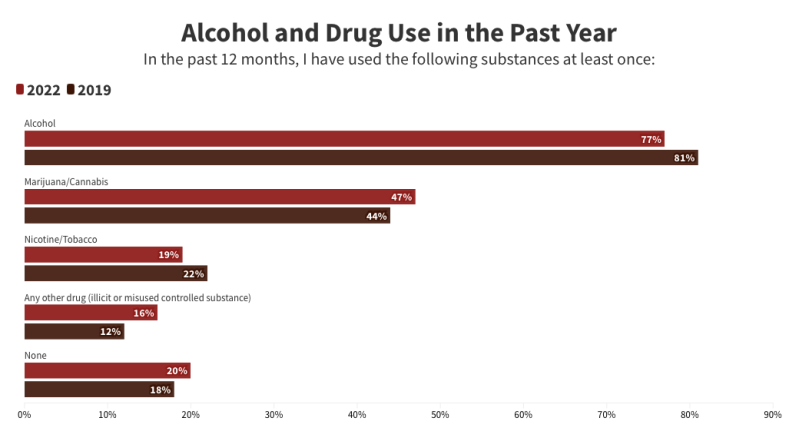Stanford has released the results for the most recent “Alcohol and Drug Use Survey,” a survey distributed to all undergraduate students about substance use and behaviors on campus. Compared to 2019’s results, students reported being more likely to engage in high-risk behaviors with substances as well as disagreement with current University policies on drug and alcohol.
The most recent results were gathered during spring quarter of 2022 from the undergraduate student population with a response rate of 37%. Compared to the results gathered in 2019, rates of substance use remained about the same while rates of high-risk behaviors such as binge drinking increased.
“We administer this survey in order to understand over time the behaviors and patterns around alcohol and other drug use and to understand what attention is needed to reduce harms in our community,” Vice Provost for Student Affairs Susie Brubaker-Cole said in a Stanford Report.
Along with substance use, the survey also asked students’ attitudes on the University’s alcohol policies. Less than 10% of respondents agreed to any extent that the current alcohol and drug policies positively influenced their life or campus culture.
According to the survey, some of the most common reasons why students disagree with the current policies is that it creates a “more dangerous drinking environment” and generates “a culture of fear and secrecy.”
The Daily has reached out to the University for comment about student criticisms of the current alcohol policies.
General Alcohol & Drug Use
Alcohol was the most commonly consumed substance amongst the survey respondents with a majority of students reporting drinking alcohol in the year prior to taking the survey.
According to the student respondents, the most common reasons for drinking alcohol were “to have a good time with my friends” and “to celebrate.”
About 55% of survey respondents who consumed alcohol in the 30 days prior to taking the survey reported binge drinking, which the survey defined as “4-5 or more drinks in a two-hour period.”
The 2022 survey’s results showed that among the respondents who drank alcohol in the last 30 days, hard liquor mixed drinks and hard liquor shots were the most common ways students consumed alcohol. In contrast, the most common ways to consume alcohol in the 2019 survey were beer and wine.
Students in 2022 were also more likely to report having a hangover due to alcohol consumption, forget where they were or what they did due to alcohol over-consumption and vomit due to alcohol over-consumption.
About 71% of frosh respondents in the 2022 survey who drank in alcohol in the last 30 days reported that they typically consume hard liquor in contrast with 38% of seniors.
The survey data also demonstrates an increasing trend of substance use by class cohort; seniors and juniors are more likely to have consumed substances at least once in the past year compared to frosh.
Greek Life
Students who identified as being in a Greek-lettered organization had increased rates of using substances in the year prior to taking the survey.
According to Stanford Residential & Dining Enterprises, about 25% of students are a part of a fraternity or sorority.
Students in Greek-lettered organizations also reported consuming alcohol more frequently with 20% of Greek respondents reporting that they drank alcohol 10 or more days out of the prior 30 day period. Binge drinking was also more common amongst students in Greek life with 76% of Greek respondents reporting binge drinking within the past two weeks. In comparison, 48% of non-Greek respondents reported binge drinking within the past two weeks.
Only about 5% of Greek respondents reported not using substances at all in the past year.
Cannabis, Tobacco and other Drugs
According to the survey, approximately half of respondents came to college with the intention of using cannabis with 44% reporting actually using it in the past year. Of these respondents, the most common intention behind using it was “to explore or experiment.”
Among survey respondents who reported using cannabis in the past year, 77% used the substance in the prior 30 days.
About 76% of survey respondents had no intention to use other drugs (not including cannabis, nicotine or tobacco) when first coming to campus. Among the respondents that reported using other drugs in the past 12 months, hallucinogens (such as Psilocybin or LSD) were the most commonly used.
